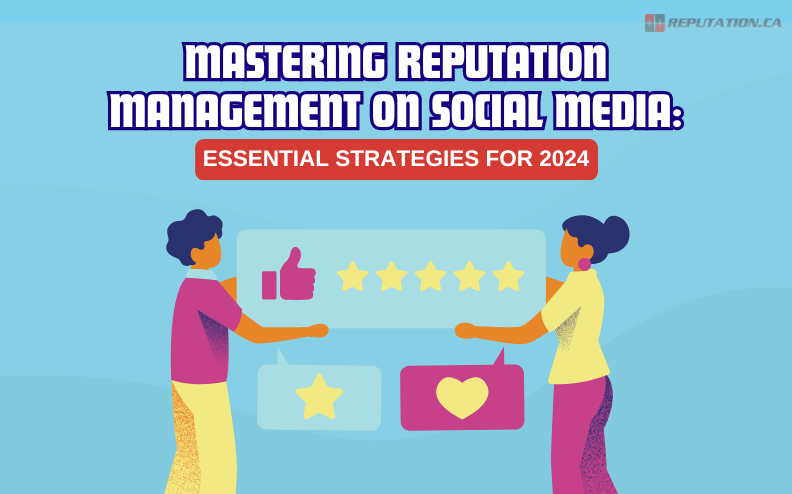Navigating the complexities of reputation management on social media is crucial for any brand in the digital age. This article outlines key strategies to monitor, shape, and maintain your social media presence, ensuring your brand is viewed positively by your audience. Learn how to respond to feedback, manage crises effectively, and harness the power of social listening to keep your reputation strong in 2024.
Key Takeaways
- Social Media Reputation Management (SMRM) is crucial for shaping a brand’s online perception, impacting brand image, customer trust, and ultimately driving business success through active engagement and response strategies on platforms like Facebook, Twitter, and LinkedIn.
- Building a strong social media presence is essential, involving consistent branding and messaging, producing engaging and valuable content, and fostering active community engagement, which collectively work towards enhancing a brand’s reputation and encouraging customer interaction.
- Proactively monitoring and responding to online conversations and feedback using social listening tools, adhering to best practices for customer interaction, and preparing for negative reviews and crisis situations with a comprehensive plan are key to maintaining a positive brand reputation.

Social Media Reputation Management (SMRM) is the active process of monitoring and influencing your brand’s presence on social media platforms to shape and maintain a positive perception online. It includes tasks such as monitoring feedback, including positive reviews, responding appropriately, and managing your online reputation. Its significance lies in its ability to impact a brand’s image and success in today’s digital age.
A brand’s business success is significantly influenced by its social media reputation. It significantly shapes the contemporary customer journey and has the potential to either enhance or diminish a business’s reputation through social media posts, thereby directly impacting its revenue and growth prospects. Failure to effectively manage a brand’s social media reputation can have detrimental effects on its image and may lead to a decline in revenue, underscoring the importance of online reputation management efforts in sustaining a thriving business.
The Impact on Brand Perception
A positive brand reputation on social media has the potential to enhance customer trust by demonstrating the brand’s reliability and integrity. A company’s credibility is substantially influenced by its social media reputation. Positive feedback can elevate the brand’s standing, while negative comments can tarnish its reputation and reduce its credibility, highlighting the importance of managing social media reputation.
Handling reputation on social media effectively is key to customer loyalty as it bolsters trust, credibility, and reinforces brand image. This can result in heightened brand awareness and potentially increased sales through well-managed social media pages. For instance, Nike and JetBlue are noteworthy instances of companies that have utilized social media reputation management to improve their overall brand perception. They have been successful in using social media to track online conversations and engage with their audience effectively.
Social media platforms significantly shape a brand’s reputation through audience interaction, feedback response, and showcasing the brand’s identity. Brands can leverage platforms like Facebook and Instagram to influence consumer perceptions and cultivate loyalty, while Twitter’s immediacy facilitates prompt reputation management strategies.
Facebook contributes to brand reputation management by providing a platform for brands to directly engage with their audience, address feedback, and effectively showcase their brand identity and values. This helps in understanding and managing customer sentiment effectively. Twitter, on the other hand, can be employed for proactive reputation management by making use of its advanced search tool to monitor brand mentions, engaging with the audience to cultivate a positive online reputation, utilizing social listening to gain insights into public perception, and using social media marketing to grow your current audience through ads.
LinkedIn impacts a company’s corporate reputation by:
- Fostering trust and providing value through its platform
- Shaping the perception of a brand among its members
- Actively overseeing their advertising experience
All of these factors are crucial for upholding a positive brand’s online reputation.

Establishing a positive brand image necessitates building a strong social media presence. It involves three key elements: consistent branding and messaging, engaging and valuable content, and active community engagement. Consistency in branding across social media platforms can increase revenue by 10 to 20%, as it establishes familiarity, reduces confusion, and signals professionalism.
Engaging content, on the other hand, is crucial in capturing the audience’s attention and promoting interaction. Active community engagement is the final piece of the puzzle. It involves:
- Posting content
- Interacting with followers
- Responding to comments
- Fostering a community around the brand
This level of engagement demonstrates a brand’s commitment to its audience and can significantly enhance its social media reputation.
Consistent Branding and Messaging
Due to its function in promoting brand recognition, aiding brand recall, establishing customer trust, and enhancing audience engagement, maintaining consistent branding on social media platforms is key. To uphold brand consistency across different social media platforms, it is advisable to:
- Formulate a comprehensive social media strategy
- Guarantee uniformity of logo, color palette, typography, and imagery across all channels
- Harmonize the brand message throughout the diverse social media platforms
Several examples of brands that have successfully maintained consistent messaging on social media include:
- Adidas
- Lidl
- Apple
- FlixBus
- Sephora
These brands have been able to establish a strong social media presence through a consistent brand identity, which has reinforced their brand image and enhanced their online reputation.
Engaging and Valuable Content
Another key aspect of building a strong social media presence is the creation of engaging and valuable content that connects with your target audience. Brands can develop resonating content by embracing authenticity, narrating stories that add a human touch to the brand, emphasizing brand values, and presenting customer experiences. Additionally, the content should offer value by addressing audience inquiries and providing solutions to their challenges.
Compelling and valuable social media content can take many forms, including:
- Short-form videos
- Behind-the-scenes glimpses
- Before-and-after posts
- User-generated content
- Live streams
- Polls and questions
- Influencer partnerships
- Entertaining and educational content
- Contests
- Quotes
- Podcasts
- Articles
- Infographics
- Webinars
- Customer testimonials
All these content types can significantly enhance the audience’s engagement and interaction with the brand.
Active Community Engagement
Active community engagement extends beyond just content creation and sharing. It’s about fostering meaningful relationships with your audience, responding to their comments and inquiries, and creating a sense of community around your brand. Successful brands effectively manage community engagement on social media by:
- Actively overseeing their social media community
- Interacting with their audience
- Establishing a social media community presence across various platforms.
Some strategies for cultivating genuine connections with followers on social media include:
- Actively engaging with them
- Connecting by commenting on their posts
- Maintaining consistency
- Embodying genuine interactions
- Discussing shared interests
- Encouraging user-generated content to allow followers to share their own experiences and stories with your brand.
Monitoring and Responding to Online Conversations

Proactive reputation management necessitates monitoring and responding to online conversations. By tracking what’s being said about your brand on social media, you can address any potential issues before they escalate, and ensure that your brand’s image remains positive. Timely and professional responses to customer feedback on social media are essential for maintaining a positive brand image. When addressing positive feedback, it is advisable to express gratitude, provide personalized responses, and encourage continued interaction.
In the case of negative feedback, it’s important to remain polite, offer sincere apologies, and avoid making unrealistic assurances. This approach ensures that the customer feels acknowledged and valued, and can help to maintain a positive brand image. Actively participating in online discussions can have a positive impact on a brand’s reputation by showcasing responsiveness, fostering trust, displaying dedication to addressing customer issues, and potentially averting the erosion of customer loyalty that may result from neglecting or mishandling these interactions.
Monitoring and responding to online conversations significantly relies on the use of social media monitoring tools. Tools like HubSpot Social Media Management Software, Brand24, Hootsuite, and other social listening tools can help businesses track and manage their online reputation effectively. Some social listening tools can offer a dashboard where users can monitor mentions, keywords, and hashtags across various social media channels.
A free social listening tool that you can use to start with is Google Alerts. This tool allows you to track online mentions of your brand or keywords by sending you email updates, keeping you informed about what’s being said about your business in real-time. It’s an excellent way for beginners to dip their toes into the vast ocean of social listening without any upfront investment. By setting up alerts for your brand name, industry buzzwords, and even competitors, you can stay on top of important conversations and react swiftly to both positive and negative mentions.
Best Practices for Responding to Feedback
There are several best practices to keep in mind when responding to feedback on social media. First, always respond promptly and professionally. Whether the feedback is positive or negative, a quick response shows that you value your customers’ opinions and are committed to addressing their concerns.
Empathy also plays a crucial role in responding to feedback. By showing understanding and willingness to resolve the issue, you can help to defuse the situation and facilitate a more favorable outcome. Transparency, too, is key. By being open and honest in your communications, you can build trust and establish a sense of dependability among your audience.
Managing Negative Reviews and Crisis Situations

Negative reviews and crisis situations are an unavoidable part of social media. The way you handle these situations can greatly affect your brand’s reputation. Proactive reputation management involves implementing preventative measures to cultivate a favorable brand image and mitigate potential risks.
It also involves actively soliciting feedback from customers, which can help you identify potential issues before they escalate. In order to effectively manage negative reviews, a business should:
- Maintain a composed, transparent, and honest approach when responding
- Learn from the feedback and refrain from impulsive reactions
- Craft personalized, courteous, and suitable responses
These actions can contribute to resolving the situation.
Proactive Reputation Management
Proactive reputation management entails implementing preventative measures to foster a favorable brand image and reduce potential risks. It’s about taking control of your brand’s online reputation before a crisis occurs. This involves:
- Regularly monitoring your brand’s social media presence
- Addressing any emerging issues or gaps
- Continuous monitoring and engagement to uphold a positive reputation.
Monitoring and analyzing online conversations and reviews can help you identify potential reputation risks before they escalate. By utilizing online reputation monitoring tools such as Sprout Social, Hootsuite’s Reputology, and Visualping, you can collect and analyze brand-related conversations and track reviews across various platforms and websites.
Crisis Communication Plan
Having a well-prepared crisis communication plan is a vital component of reputation management. When a crisis occurs, you need to be ready to respond quickly, transparently, and professionally. A crisis communication plan allows you to:
- Respond quickly to the crisis
- Communicate transparently with your audience
- Maintain a professional image
- Minimize damage to your brand’s reputation
Your plan should prioritize the following actions:
- Swift reactions
- Halt automated posts
- Establish a crisis response team
- Closely monitor social media channels
- Create and uphold a consistent message
- Promptly and transparently respond
- Offer regular updates
- Assess the crisis post-resolution to gain insights for enhancing future responses.
In times of a social media crisis, it’s important to keep stakeholders informed and reassured while maintaining clear and consistent communication.
Leveraging Influencers and Partnerships

The power of influencers and partnerships lies in amplifying positive messages and extending reach to new audiences. By leveraging these resources, you can enhance your brand’s reputation and increase your reach on social media platforms.
Selecting the right influencers for your brand involves:
- Taking into account your marketing campaign objectives
- Understanding your target audience
- Focusing on influencers who resonate with your brand
- Assessing their reach and engagement
- Evaluating the quality and authenticity of their content
Partnerships, on the other hand, can enhance reach, foster trust, and elevate a business’s reputation.
Identifying the Right Influencers
In influencer marketing, a critical aspect is identifying the right influencers for your brand. The right influencers can enhance your brand’s reputation, reach a wider audience, and drive more traffic to your website.
The selection of influencers in social media reputation management is influenced by the target audience as influencers possess the ability to mold online reputation through trust-building, expanding reach, and targeting specific audiences. It’s also important to evaluate their values by examining their content, following, and past partnerships. This ensures that they align with your brand and can effectively promote your products or services.
Managing Influencer Relationships
Maintaining a positive brand image necessitates effective management of influencer relationships. This involves setting clear expectations from the beginning, maintaining transparent communication, and treating influencers as partners. Additionally, it’s important to identify influencers who naturally align with your brand. This can help to ensure a mutually beneficial partnership and maintain a positive brand image.
Influencers contribute to upholding a positive brand image on social media by shaping brand perception with their personal experiences and opinions, and by endorsing a brand’s products or services in their content.
SMRM heavily depends on measuring and analyzing social media reputation metrics. By tracking progress and making data-driven decisions, you can continuously improve your brand’s reputation on social media.
The primary performance indicators for evaluating social media reputation encompass follower count, impressions, post reach, web traffic, engagement rate, reach, and share of voice. Several tools are available for analyzing social media reputation metrics, including social media analytics tools such as Hootsuite, Sprout Social, and Influencer Marketing Hub.
Key Performance Indicators (KPIs)
The success of your SMRM efforts can be measured using Key Performance Indicators (KPIs). Some important KPIs to consider are:
- Engagement rate
- Reach
- Impressions
- Website traffic
These metrics can provide valuable insights into the effectiveness of your efforts.
Engagement rate, for instance, is a pivotal performance indicator in SMRM due to its ability to gauge the audience’s active involvement with the content. Sentiment analysis, another crucial performance metric, can be utilized for monitoring brand perception through sentiment analysis.
Brand mentions can be tracked and analyzed by utilizing media monitoring tools to collect and analyze all online and social media references to the brand.
Regular Reporting and Analysis (KPIs)
To track progress and identify areas for improvement, regular reporting and analysis of SMRM metrics is necessary. By keeping a close eye on these metrics, you can make data-driven decisions that improve your brand’s reputation.
Reports for social media reputation management should be generated either daily or weekly, based on the necessity to monitor brand mentions and timely conversations. Several tools for analyzing social media reputation metrics are available.
Summary
In summary, Social Media Reputation Management (SMRM) is crucial for any business in today’s digital landscape. By building a strong social media presence, monitoring and responding to online conversations, managing negative reviews and crisis situations, leveraging influencers and partnerships, and measuring and analyzing SMRM metrics, you can ensure that your brand’s image remains positive and strong.
Remember, your brand’s reputation on social media can significantly impact its success. Therefore, it’s essential to take a proactive approach to SMRM. By implementing the strategies discussed in this blog post, you can effectively manage your brand’s reputation, enhance customer trust, and ultimately boost your business’s success.
Frequently Asked Questions
Social media holds immense power in shaping reputations, as positive content can elevate it while negative feedback can damage it. The platforms like Facebook, Twitter, and Instagram can significantly influence how consumers perceive a brand.
To fix your social media reputation, start by refocusing on your ideal client, staying calm, responding positively, using hashtags judiciously, and sharing valuable information with your audience. These steps can help you rebuild a tarnished online reputation and regain trust.
How do you manage online reputation effectively?
To effectively manage your online reputation, create a strategy by choosing a reputation management tool, gathering data from external sources and customers, reviewing brand experience, and being proactive in promoting positive aspects. Then, be ready to respond to online reviews and social comments to close the loop. A good reputation management strategy requires proactive measures to ensure a positive brand image in the online space.
Utilizing social media for reputation management enables organizations to engage directly with their audience, address issues promptly, and enhance brand perception, ultimately earning respect and a positive reputation online.











